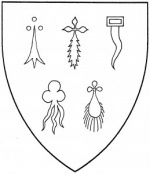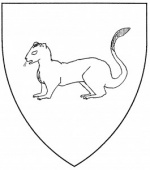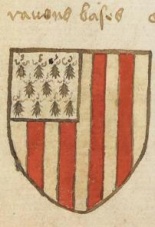Ermine, Ermined Tinctures
WARNING: Do not cite this page as a reference. This page is on this wiki only to make the content "searchable" and easier to find. If you find the information you seek here, go to the original sources as linked below to verify the information and use them for your documentation.
See also Furs.
Illustrations:[edit | edit source]
Period sources:[edit | edit source]
Modern:[edit | edit source]
Pictorial Dictionary of SCA Heraldry (3rd edition):[edit | edit source]

|

|
| Five different types of ermine spots (period) | An ermine statant (period) |
Pennsic Traceable Art Project:[edit | edit source]
Glossary of Terms[edit | edit source]
Ermined Tinctures: These are heraldic furs. There are many possible varieties of these, all based on the design of strewn ermine spots (abstract designs representing ermine tails). The most common are ermine (argent with sable ermine spots), counter-ermine (sable with argent ermine spots; also known as ermines, a term that is not used in the SCA due to the possibility of typographic errors), erminois (Or with sable ermine spots) and pean (sable with Or ermine spots). Other combinations do not have unique names and must be explicitly blazoned as <tincture> ermined <tincture>, e.g., gules ermined argent (gules strewn with argent ermine spots). Unlike other designs featuring strewn charges, the ermine variants are furs and are classed as separate tinctures in their own right, rather than as charged fields. However the ermine spots have the same constraints as charges for purposes of contrast under RfS VIII.2, in that they must have good contrast with the tincture on which they are placed. Azure ermined gules does not have acceptable contrast. For contrast purposes, these furs are classed either as colors or metals according to their underlying tincture (so ermine is classed as a metal, and pean is classed as a color). Ermine spots can also be used as normal charges; if not in a strewn arrangement they are treated no differently from any other charges. See also Field Treatment, Furs, Semy, Tincture.
Period Treatises and Information:[edit | edit source]
- Ermine* is found in the earliest rolls, eg. Dukes of Brittany.
- Counter-ermine* (as called in the SCA) is mid-to-late 15th C. The Randle Holme Roll has the arms of John Garther as what an SCA herald might blazon as *Checky of nine pieces counter-ermine and ermine*. (Or, if you prefer, *Counter-ermine, a cross quarter-pierced ermine*.) Note that *counter-ermine* was so new at the time that the roll's author had no word to distinguish it from *ermine*: the Roll actually blazons Garther's arms as *of ix pecys ermy[n~] and ermyne*. We have to guess that the markover the final N denotes a contraction for *ermyn[ees],* which became the more usual English term for the fur.
As for *erminois* and *pean*, they seem to be Tudor. There's an example of what's now called *erminois* in the arms of Meery, c.1510: *Gules, on a fess engrailed argent between three water-bougets erminois, a cross formy sable bezanty between two cloves sable*. [cf. _Dictionary of BritishArms_, vol.III, p.489, and Gwynne-Jones, _The Art of Heraldry_, p.98]
- Pean* is described (along with the other three ermine furs) in Legh's _Accedence of Armory_, 1562, f.76.
Pean" in SENA: The end of Appendix F accepts it by reference, and A2B1 allows it as a heraldic element asserted in a period treatise "even if it is unclear from the treatise if the element was used in actual heraldry".
There's a mention in Hierosme de Bara (1581) about Ermines of a Different Color: http://books.google.com/books Car l'Hermine est d'argent & de sable, & le Vair d'argent et d'azur. Toutesfois en blasonnant on ne les specifie pas, mais en un mot on dir: Tel seigneur porte d'Hermines ou de Vair, except{e'} quand ils son d'autre metal & couleur: caralors on doit dire: Tel Siegneur porte d'Hermines, ou de Vair, d'Or, Synople, Gueulles, ou autre. Comme sera veu cy apres, par les figures des Escus suyuans. Effectively, "Because ermine is argent and sable, and vair is argent and azure, you don't specify in the blazon when it's those colors, but when you use another metal and color, say what they are. The gentleman bears ermine, or vair, Or, vert, gules, or other. As shown later, in the following illustrated shields." A few pages later, there's "D'or, {'a} trois Hermines de gueulles" blazoned, and the scanned version is colored. It also blazons out Pean and Erminois as colors (sable sem{e'} d'Hermines d'or") ... and if you page to page 46, you will see "Argent ermined vert" where the ermine spots are upside down. Not quite blazoned that way - 'mouchet{e'}' is a term for the ermine spot, and the blazon is "Argent, ermined, plumetty, or (decouppe?) of vert Alternately, one says argent plumetty or (decouppe?) on or of vert."
Erminites is apparently mentioned in Legh, The Accadens of Armory, 1562. Each spot has a red tail on one side, the rest black. Pean is also mentioned here. It goes on to say there are others that should just be named by the color and metal they are. And that these are commonly called "Grytty of Herehaughtes".
Sources:[edit | edit source]
Academy of St. Gabriel "Medieval Heraldry Archive" - http://www.s-gabriel.org/heraldry/
Archive of St. Gabriel reports - http://www.panix.com/~gabriel/public-bin/archive.cgi
Laurel Armory Articles - [[1]]
New Heraldic Primer (Heraldry for Non-Heralds) - http://heraldry.sca.org/armory/newprimer/h4f4.shtml
Pictorial Dictionary of Heraldry (PicDic), 3rd Edition - http://mistholme.com/pictorial-dictionary-of-heraldry
Period Armorials
Precedents:[edit | edit source]
Precedents of the SCA College of Arms - http://heraldry.sca.org/laurel/precedents.html
Morsulus Heralds Website - http://www.morsulus.org/ (to search the LoARs and Precedents)
Restatement Wiki - http://yehudaheraldry.com/restatement/index.php?title=Main_Page]] (restatements of Precedents)
Use the above links to be sure any precedents listed below haven't been superseded by newer precedents.
Definition:[edit | edit source]
November 2001 - ermine furs are tinctures not strewn charges:[edit | edit source]
The College should please keep in mind, while performing stylistic analysis and conflict checking, that ermine spots which are part of an ermine(d) tincture are not strewn charges. They are just part of the tincture, like the lozenges in lozengy or the delfs (squares) in checky are part of a tincture.
- November 2001 LoAR
October 2000 - weasel vs ferret tail:[edit | edit source]
Blazoned on the LoI as ferrets, the creatures on the emblazon do not have ferret's tails, which are narrow with a tuft at the end. Instead, these creatures have the thick fuzzy tail of the weasel. As there is an artistic if not heraldic difference, we have changed the blazon to match the emblazon. [Donatien Delaborde, 10/00, A-Ansteorra]
Registerability:[edit | edit source]
(Restricted, Reserved, SFPP, OOP)
May 2012 - Ermine Variants[edit | edit source]
Section A3B1 of the Standards for Evaluation, Tinctures, states:
- Furs are a group of named patterns used as tinctures. For the purposes of tincture, ermined furs are grouped in the same way as their background color. Ermine (a white background with black tails) and erminois (a yellow background with black tails) are metals.Counter-ermine (a black background with white tails) and pean (a black background with yellow tails) are colors.
This, along with lack of other ermine variants listed in Appendix F, has been frequently interpreted to mean that "non-standard" ermine variants are no longer allowable under the Standards for Evaluation. However, that was not the intent of Palimpsest. As the rule is written, it is describing what the specifically-named patterns represent; it makes no mention good or ill of other ermine variants, which we blazon as X ermined Y.
- Research on period examples of ermine variants was mixed. We have found several examples, unfortunately undated. Woodward's A Treatise on Heraldry, British and Foreign, Vol. 1, p. 76, lists quite a few examples as "foreign variations". Most can be found repeated in Rietstap. Woodward cites Roux, which is repeated in Rietstap as Roux alias Roulx du Chesnot, Azure, semy of ermine spots argent, an eagle Or armed gules. Woodward and Rietstap cite Van Leefvelt, Gules, semy of ermine spots Or, Beuville, Gules, semy of ermine spots, a fleur-de-lys argent, and Schleiden, Azure, semy of ermine spots Or, a lion argent. Woodward goes on to cite examples of ermine spots used as discrete numbered charges, including Baysse with Gules, six ermine spots Or. All of these examples are likely post-period, although they could just as easily date to late period.
- Closer to period, we have Abbrege' methodique des principes de la science heraldique, by Jean-Claude Favre, 1647, which on p. 30 gives the specific example of "11. Monsieur tel porte d'hermine, d'azur & d'argent".
- And finally, for a definite period source, we have Les Blason des armoiries, by Hierome de Bara, 1581, which on p. 9 says "Car l'Hermine est d'argent & de sable, & le Vair d'argent & d'azur. Toutesfois en blasonant, on ne les specifie pas, mais en vn mot on dit: Tel Seigneur porte d'Hermines, ou de Vair, excepté quand ils sont d'autre metal & et couleur, car alors on doit dire: Tel Seigneur porte d'Hermines, ou de Vair, d'Or, Synople, Gueulles, ou autre." On p. 13 de Bara gives the specific example of //Gules, three ermine spots Or. Brunissende Dragonette was kind enough to give the following translation: "Ermine is argent and sable, and Vair is argent and azure. However, one doesn't specify when blazoning, but just says: This Lord bears Ermine or Vair; unless they are of another metal and color, as then one must say: This Lord bears Ermine or Vair Or, Vert, Gules or other."
The latter two sources are heraldic treatises, which are not always to be trusted for actual practice, as opposed to theoretical. However, they do give us a guide as to the sorts of things period and just-post-period heralds felt were suitable for use in armory.
- The SCA is its own heraldic jurisdiction; as section A1A1 of the Standards for Evaluation states, "Our core style is not identical to the style of any single specific place and time, although it is based on the dominant style in medieval Western Europe, the Anglo-Norman style" At worst, ermine variants are post-period, but a logical and unremarkable extension of period heraldic style; at best, they are indeed period. Therefore, we hereby clarify that ermine variants in all tincture combinations are allowable without a step from period practice so long as the rule of contrast is followed.
We propose a wording change to Appendix F of the Standards for Evaluation. It currently reads:
- The main heraldic tinctures are listed in A.3.B.1. Other heraldic tinctures may only be registered as part of an Individually Attested Pattern.
We would like commentary on the following proposed change:
- The main heraldic tinctures are listed in A.3.B.1. Furs are treated as a single tincture; a fur may combine any color with any metal (for example, gules ermined Or, vairy argent and sable). Other heraldic tinctures may only be registered as part of an Individually Attested Pattern.
http://heraldry.sca.org/loar/2012/05/12-05cl.html
Conflict:[edit | edit source]
Identifiability:[edit | edit source]
Collected Precedents:[edit | edit source]
- 2nd Tenure of Elisabeth de Rossignol (April 2011 - August 2011) - Collected Armory Precedents
- 1st Tenure of Elisabeth de Rossignol (May 2005 - July 2008) - FUR
- 2nd Tenure of François la Flamme (October 2004 - May 2005) - Collected Armory Precedents
- The Tenure of Shauna of Carrick Point (May 2004 - August 2004) - Collected Armory Precedents
- 1st Tenure of François la Flamme (August 2001 - April 2004) - Collected Armory Precedents
- The Tenure of Elsbeth Anne Roth (June 1999 - July 2001) - Collected Armory Precedents
- The Tenure of Jaelle of Armida (June 1996 - June 1999) - Single HTML Document
- 2nd Tenure of Da'ud ibn Auda (November 1993 - June 1996) -
- The Tenure of Bruce Draconarius of Mistholme (June 1992 - October 1993) - Collected precedents
- 1st Tenure of Da'ud ibn Auda (June 1990 - June 1992) -
- The Tenure of Alisoun MacCoul of Elphane (September 1986 - June 1990) - Collected Precedents
- The Tenure of Baldwin of Erebor (August 1984 - August 1986) - Single HTML Document
- The Tenure of Wilhelm von Schlüssel (August 1979 - August 1984) - Collected Precedents
- The Tenure of Karina of the Far West (December 1975 - June 1979) - Collected Precedents
- The Early Days (June 1971 - June 1975) - Collected Precedents
In the Ordinary:[edit | edit source]
- Ermine - Beast - see Beast - Weasel
- Ermine spot - see also Field treatment - Ermined
- Ermine tail - see Ermine spot
- Ermined - see Field treatment - Ermined
